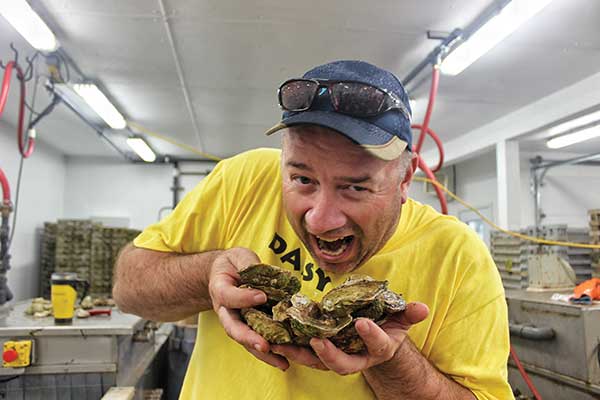See Nova Scotia like you’ve never seen it before—from a motorcycle sidecar
It’s a cloudless May day in Halifax. Perfect conditions—too chilly for flies; warm enough to feel the sun on our cheeks. My husband and I are pumped. We’re about to spend the afternoon on a motorbike, only we’re not driving. Each of us is sitting in a 2010 URAL Patrol sidecar. I’m next to Vicki Gesner in her rig; Barrie’s in Kevin Wile’s rig.
Vicki speaks into her microphone to make sure that the radios in our helmets are working. “Can you hear me?” Check. “Comfy?” Check. Warm enough?” Check.
We glide off from the parking lot in front of the VIA Rail station, where we agreed to meet, and motor along onto Lower Water Street. I’ve been on this street hundreds of times, but today, it’s different. I see both sky and pavement—and everything in-between. Passing a coffee shop, I get a whiff of brew and feel heady. I’m liking this a lot, and feeling pretty pleased with myself for arranging this jaunt with Bluenose Sidecar Tours.
Custom tours
Vicki and Kevin offer half- and full-day trips focused on Halifax, Peggy’s Cove and Lunenburg, but are more than willing to customize a trip—as they did for writer Sandra Phinney. They’ve taken visitors to the Annapolis Valley and to Liverpool overnight and suggest that anything’s possible (within reason, of course). Information: bluenosesidecartours.ca.

Tartan inspiration
You can learn about the Nova Scotia Tartan at the S.S. Atlantic Heritage Park interpretation centre in Terence Bay, NS, which is a regular stop on the Peggy’s Cove tour. This year, Nova Scotia marks the 60th anniversary of the Tartan. The blue represents sea; the greens for both deciduous and evergreen trees; gold represents the Royal Charter in Nova Scotia; and red symbolizes the lion on the provincial flag. Folks at the Heritage Park say that the white line was inspired by the white granite rocks in Terence Bay.
Born in Barcelona
In the winter of 2011, Vicki was planning a trip to Barcelona with Kevin. In the process of doing some research, the former radio broadcaster discovered a company that offered sidecar tours. She woke up one morning (before their trip) and said to her husband, “Kevin, we should do that here—give sidecar tours. We’re on our bikes all summer, and no one else is doing it.” Kevin’s response was to tell her to go back to sleep, but two months after they returned from Barcelona, Bluenose Sidecar Tours was up and running.
As we drive by the naval dockyards, Kevin—who also works there as a communications technician—tells us how submarines are lifted from the water. Before we know it, we’re pulling up to the Africville Museum—a place that’s loaded with history. We hear how the residents of Africville were relocated. Vicki explains how it was done and why people are still upset. It’s a sobering and poignant story. The stop here also gives our guides a chance to explain the history of black settlers in Nova Scotia.
Before leaving the city, we veer into Fairview Lawn Cemetery to visit graves of the Titanic victims. We hear little-known stories, including one about a victim who was buried in the adjacent Baron de Hirsch Cemetery. “That’s the Jewish cemetery,” Vicki says, “But he wasn’t Jewish. Turns out he was using an assumed name to steal his two children away from his estranged wife. The happy ending is that children survived the sinking and were reunited with their mother in Europe.”
History with a twist
Eventually, we head out of the city toward a historic lighthouse in Terence Bay, and make a pit stop at the S.S. Atlantic Heritage Park interpretation centre in that community. Now there’s a story. On April 1, 1873, the luxury steamship S.S. Atlantic ran aground, carrying 952 passengers. This was the worst marine disaster to occur off the Canadian coast prior to the Titanic; 562 people died, including all of the women and children, with the exception of one boy. Thanks to the brave and heroic deeds of the residents of Terence Bay, 390 passengers were saved. 
The Centre houses a small museum with artifacts from the ill-fated ship. It’s also home to a small café, and has a gift shop and curios section that features a fascinating bit of history about the Nova Scotia Tartan (see “Tartan Inspiration,” page 19).
After a free and informative guided tour of the museum, we hunker down for a big pot of tea and a feed of gingerbread, although our server bemoans the fact that there’s none of Shirley Little’s blueberry cake left, as it’s reputed to be the best in the province (see the recipe for Shirley’s Blueberry Cake, left). Vicki tells us a story about bringing visitors from the southern US to this café last Thanksgiving; they rolled up, hoping for a cup of coffee and a piece of pie. Not only did they get coffee and pie; Shirley and her husband, who both volunteer at the centre, invited everyone to join them for the turkey dinner they’d brought for their own lunch! There are so many stories in this wee place.
Mind you, our guide has his own brand of storytelling. If there’s someone playing the bagpipes at Peggy’s Cove, you’ll likely hear Kevin quip, “What’s the difference between onions and bagpipes? No one cries when you chop up bagpipes.” Deep down though, he says, he loves them and wishes he could play them.
On our way back through Lower Prospect, we stop to gawk at a miniature village created by folk artist Charlie Norris. I shake my head in wonder, take a few pictures and wave goodbye to the wooden figures in the village. “We’ll be back,” I tell them. And we will.



